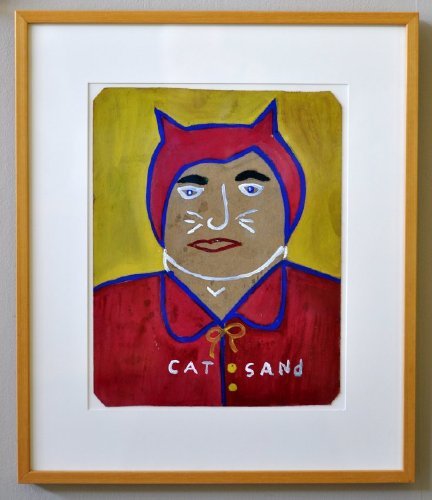Comments
"Poignant stories. Very interesting."
"Totally speaks to the goodness of life. Beautiful."
"I love this. Going to come back."
"Beautiful."
"Makes me want to explore making art with found objects - creativity truly is limitless!"
We really value visitor comments about South Dakota Art Museum exhibitions and your experience at the museum or here on our website. Please take a moment to send us your comments and let us know if we can share them here. We also appreciate visitor reviews on Google, Tripadvisor, Facebook and other social sites!
Contemporary folk art, sometimes called “outsider” art, refers to artwork created by self-taught artists who work outside the mainstream art scene. The term was coined by the British art scholar Roger Cardinal in 1972 as an English synonym for “art brut” (from a French phrase that translates as “raw art”), a term originated by the French painter Jean Dubuffet to describe art created outside the boundaries of official culture. While Dubuffet’s “art brut” referred specifically to artwork created by psychiatric hospital patients or children, Cardinal’s term applied generally to art created by self-taught artists who may never have been institutionalized but who nevertheless felt compelled, called, divinely inspired by God or driven by inner voices to create artwork.
The history of folk or outsider art dates back to the 17th and early 18th centuries in the United States when itinerant and self-taught painters traveled from town to town to paint portraits or “likenesses” of their early American sitters. By the end of the 18th and beginning of the 19th centuries, however, there was a clear distinction between “folk” portraits and “fine art” portraits, the former being produced by self-taught artists and the latter being created by classically trained painters. In addition, there were other self-taught artists in the nineteenth century who carved scrimshaw, made weathervanes and whirligigs, carved and painted signs and figureheads and stitched samplers and pieced quilts.
Folk or outsider art continued to flourish in the rural parts of the United States during the first few decades of the 20th century. In the 1930s, however, a number of exhibitions began to showcase the work of self-taught and outsider artists. Holger Cahill, interim director of the Museum of Modern Art in New York in the early 1930s, organized one of the first major exhibitions of American folk art in the United States. It was during this time that art collectors and wealthy patrons, such as Abby Aldrich Rockefeller and others, began to amass large collections of folk art that would eventually form the basis for some of the most significant folk art collections in this country, including the Museum of American Folk Art in New York City and the Smithsonian Institution in Washington, D.C.
From the 1940s on, there emerged a large, identifiable group of self-taught artists who became notable and collectible outsider artists in the 1960s, ‘70s and ‘80s. They tended to live in rural parts of the United States and lacked formal education. Many were the sons and daughters of sharecroppers and former slaves. Most started their artistic careers late in life and often used inexpensive and ordinary material—whatever was available and handy—to create their artwork. Some of these artists experienced visions in which God or the angels told them to make art, while others carved, painted or sewed to keep active or busy in retirement. Still others used their artwork to rail against the government or their neighbors. Artists like Rev. Howard Finster, Dilmus Hall, Nellie Mae Rowe and Mary T. Smith would emerge at this time as important figures in the folk art movement and would eventually form some of the cornerstones of the Willem and Diane Volkersz Contemporary American Folk Art collection.
Willem and Diane Volkersz, of Bozeman, Montana, began to collect folk and outside art in the 1970s. The Volkersz’ met at the University of Washington in the 1960s where Willem was working on his B.A. degree in studio art. He became fascinated with Simon Rodia’s Watts Towers in Los Angeles, and after he and Diane moved to Kansas City when he accepted a teaching position at the Kansas City Art Institute, they began to collect folk and outside art. From the late 1970s to the present, they have amassed one of the most important folk and outsider art collections in the country. It is the storytelling or narrative aspects of the artwork that particularly appeal to them. “Folk art is the development of these artists’ own unique format and imagery, and they have to tell a story,” Willem has said. “It’s something in their lives that they’ve negatively experienced, such as a divorce or death. It gives them emphasis to start telling their story, and that is what we’ve really been interested in.”
"Compelling Visions: Selections from the Willem and Diane Volkersz Contemporary American Folk Art Collection" includes a selection of pieces that Willem and Diane donated to the Missoula Art Museum. We’d like to thank MAM for lending these works to the show. We’d also like to thank and credit John Olbrantz, Maribeth Collins Director of the Hallie Ford Museum of Art at Willamette University, for giving permission to use his research and writing on the Volkersz Collection in this exhibition.
Credits
Willem and Diane Volkersz Contemporary Folk Art Collection: Courtesy of the Missoula Art Museum.











